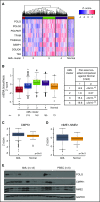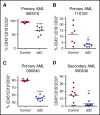Leveraging increased cytoplasmic nucleoside kinase activity to target mtDNA and oxidative phosphorylation in AML
- PMID: 28283480
- PMCID: PMC5766841
- DOI: 10.1182/blood-2016-10-741207
Leveraging increased cytoplasmic nucleoside kinase activity to target mtDNA and oxidative phosphorylation in AML
Abstract
Mitochondrial DNA (mtDNA) biosynthesis requires replication factors and adequate nucleotide pools from the mitochondria and cytoplasm. We performed gene expression profiling analysis of 542 human acute myeloid leukemia (AML) samples and identified 55% with upregulated mtDNA biosynthesis pathway expression compared with normal hematopoietic cells. Genes that support mitochondrial nucleotide pools, including mitochondrial nucleotide transporters and a subset of cytoplasmic nucleoside kinases, were also increased in AML compared with normal hematopoietic samples. Knockdown of cytoplasmic nucleoside kinases reduced mtDNA levels in AML cells, demonstrating their contribution in maintaining mtDNA. To assess cytoplasmic nucleoside kinase pathway activity, we used a nucleoside analog 2'3'-dideoxycytidine (ddC), which is phosphorylated to the activated antimetabolite, 2'3'-dideoxycytidine triphosphate by cytoplasmic nucleoside kinases. ddC is a selective inhibitor of the mitochondrial DNA polymerase γ. ddC was preferentially activated in AML cells compared with normal hematopoietic progenitor cells. ddC treatment inhibited mtDNA replication, oxidative phosphorylation, and induced cytotoxicity in a panel of AML cell lines. Furthermore, ddC preferentially inhibited mtDNA replication in a subset of primary human leukemia cells and selectively targeted leukemia cells while sparing normal progenitor cells. In animal models of human AML, treatment with ddC decreased mtDNA, electron transport chain proteins, and induced tumor regression without toxicity. ddC also targeted leukemic stem cells in secondary AML xenotransplantation assays. Thus, AML cells have increased cytidine nucleoside kinase activity that regulates mtDNA biogenesis and can be leveraged to selectively target oxidative phosphorylation in AML.
© 2017 by The American Society of Hematology.
Figures







Comment in
-
A mitochondrial drug to treat AML.Blood. 2017 May 11;129(19):2597-2599. doi: 10.1182/blood-2017-03-773200. Blood. 2017. PMID: 28495924 No abstract available.
Similar articles
-
The role of cytoplasmic deoxycytidine kinase in the mitochondrial effects of the anti-human immunodeficiency virus compound, 2',3'-dideoxycytidine.J Biol Chem. 1992 Feb 15;267(5):2856-9. J Biol Chem. 1992. PMID: 1310674
-
Increased mitochondrial DNA copy-number in CEM cells resistant to delayed toxicity of 2',3'-dideoxycytidine.Biochem Pharmacol. 2008 Mar 15;75(6):1313-21. doi: 10.1016/j.bcp.2007.12.002. Epub 2007 Dec 15. Biochem Pharmacol. 2008. PMID: 18206854
-
The antiretroviral 2',3'-dideoxycytidine causes mitochondrial dysfunction in proliferating and differentiated HepaRG human cell cultures.J Biol Chem. 2021 Jan-Jun;296:100206. doi: 10.1074/jbc.RA120.014885. Epub 2020 Dec 31. J Biol Chem. 2021. PMID: 33334881 Free PMC article.
-
The case for extracellular Nm23-H1 as a driver of acute myeloid leukaemia (AML) progression.Naunyn Schmiedebergs Arch Pharmacol. 2015 Feb;388(2):225-33. doi: 10.1007/s00210-014-1027-8. Epub 2014 Aug 15. Naunyn Schmiedebergs Arch Pharmacol. 2015. PMID: 25119778 Review.
-
[Mitochondrial disease and mitochondrial DNA depletion syndromes].Acta Neurol Taiwan. 2009 Dec;18(4):287-95. Acta Neurol Taiwan. 2009. PMID: 20329599 Review. Chinese.
Cited by
-
Targeting mitochondrial respiration for the treatment of acute myeloid leukemia.Biochem Pharmacol. 2020 Dec;182:114253. doi: 10.1016/j.bcp.2020.114253. Epub 2020 Oct 2. Biochem Pharmacol. 2020. PMID: 33011159 Free PMC article. Review.
-
The thymidine dideoxynucleoside analog, alovudine, inhibits the mitochondrial DNA polymerase γ, impairs oxidative phosphorylation and promotes monocytic differentiation in acute myeloid leukemia.Haematologica. 2019 May;104(5):963-972. doi: 10.3324/haematol.2018.195172. Epub 2018 Dec 20. Haematologica. 2019. PMID: 30573504 Free PMC article.
-
MYC-driven increases in mitochondrial DNA copy number occur early and persist throughout prostatic cancer progression.JCI Insight. 2023 Dec 22;8(24):e169868. doi: 10.1172/jci.insight.169868. JCI Insight. 2023. PMID: 37971875 Free PMC article.
-
Exploiting metabolic vulnerabilities for personalized therapy in acute myeloid leukemia.BMC Biol. 2019 Jul 18;17(1):57. doi: 10.1186/s12915-019-0670-4. BMC Biol. 2019. PMID: 31319822 Free PMC article. Review.
-
An in Situ Atlas of Mitochondrial DNA in Mammalian Tissues Reveals High Content in Stem and Proliferative Compartments.Am J Pathol. 2020 Jul;190(7):1565-1579. doi: 10.1016/j.ajpath.2020.03.018. Epub 2020 Apr 15. Am J Pathol. 2020. PMID: 32304697 Free PMC article.
References
Publication types
MeSH terms
Substances
Grants and funding
LinkOut - more resources
Full Text Sources
Other Literature Sources
Medical
Research Materials
Miscellaneous

